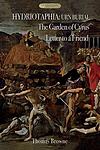The Garden Of Cyrus by Sir Thomas Browne
"The Garden of Cyrus" is a discursive, esoteric essay that delves into the symbolism and philosophy of the number five, particularly as it appears in nature and art. The work explores the quincunx pattern, which is a geometric arrangement of five points with four forming a square or rectangle and the fifth at its center. The author traverses a wide range of subjects, including the design of gardens, the structure of plants, ancient history, and the visual arts, to illustrate the recurrence and significance of this pattern throughout the natural world and human culture. The essay is known for its rich, elaborate prose and the breadth of its intellectual curiosity, reflecting the author's deep engagement with the mysteries of the cosmos and the search for underlying order in the chaos of existence.
The 7175th greatest book of all time
Ranking Details:
Our ranking system awards points to books based on their appearance and position on curated lists. Here's how it works:
Unranked Lists: For lists without specific rankings, each book receives points equivalent to the list's weight. This approach recognizes the book's inclusion on prestigious lists.
Ranked Lists: Books on ranked lists receive points in two ways:
- Base Points: Initially, every book is awarded points equal to the list's weight, acknowledging its significance.
- Bonus Points: Additionally, books earn bonus points based on their ranking. The total bonus pool, equal to 100% of the list's weight, is distributed among the books, with higher-ranked books receiving more points.
Exponential Distribution: The distribution of bonus points follows an exponential model. This means the top-ranked book (#1) receives significantly more bonus points than those further down the list (e.g., #100). Our algorithm ensures that higher placements are rewarded more generously, reflecting the achievement of a top rank on any given list.
This scoring system ensures that each book's ranking reflects both its presence on multiple lists and its positions within those lists, providing a comprehensive measure of its acclaim and popularity.
Total Points: 45
Since this book was first published in 1658, there is a penalty of 0%. The age adjusted score is 45.0.
This is to prevent newer books from reaching super high on the ranked list of the greatest books of all time. The greatest books should also stand the test of time.
- score: 45 -- Harold Bloom's The Western Canon (Weight: 45)

